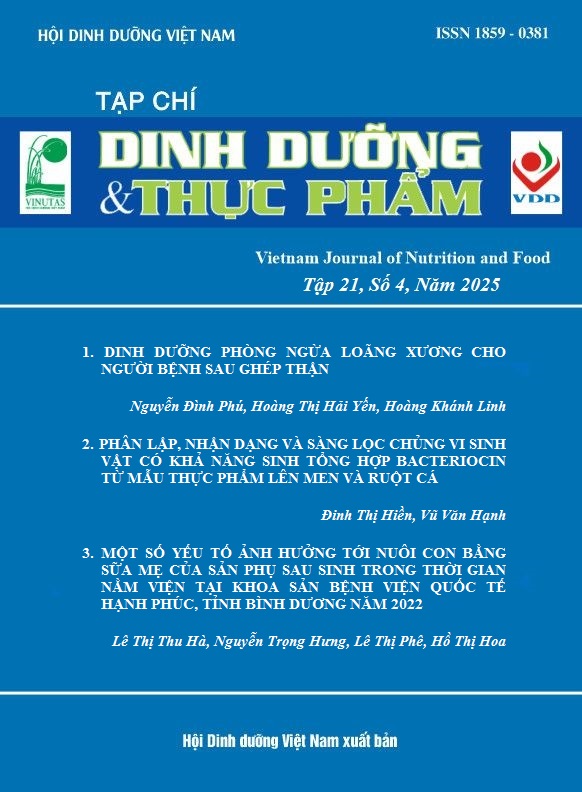STUNTING AND ITS ASSOCIATED FACTORS AMONG SECONDARY SCHOOL STUDENTS IN FOUR IMPOVERISHED DISTRICTS OF LAO CAI PROVINCE IN 2023
Main Article Content
Abstract
Aims: This study aims to describe the current situation and identify certain factors associated with stunting among secondary school students in four impoverished districts of Lao Cai province in 2023.
Method: A cross-sectional study was conducted with 1,073 secondary school students from the local region from September 2023 to December 2023. Data were collected using a questionnaire that included general information and family characteristics. Weight and height of the students were measured. Multivariable regression analysis was used to identify associated factors with stunting.
Results: The prevalence of stunting among the students was 29.3%, the highest prevalence in 11-year-old students (38.3%), while the lowest in 12-year-olds (19.6%). Among the districts, Bat Xat had the highest prevalence (44.6%), and Bac Ha had the lowest (12.6%). Stunting was significantly associated with age, district of residence, ethnicity, parents’ educational attainment, parents’ occupations, household economic status, and daily milk consumption habits.
Conclusion: The stunting prevalence among secondary school students in the four impoverished districts of Lao Cai remains high, with significant variation across districts and age groups. Stunting is associated with both individual and family-related factors.
Keywords
Secondary school students, impoverished districts, Lao Cai Province, stunting, malnutrition.
Article Details
References
2. Trần Thị Lụa, Lê Thị Hợp, Bùi Tố Loan. Tình trạng dinh dưỡng và xác định tuổi dậy thì ở trẻ gái vị thành niên tại hai vùng thành phố và nông thôn. Tạp Chí Nghiên Cứu Học. 2008;4.
3. Nguyễn Quang Dũng, Nguyễn Lân và CS. Thấp còi, nhẹ cân và thiếu máu là vấn đề có ý nghĩa sức khỏe cộng đồng trên học sinh 11-14 tuổi tại huyện Phổ Yên, Thái Nguyên. Tạp chí Y tế công cộng. 2008;10 (10): 26-31.
4. Cách phân loại và đánh giá tình trạng dinh dưỡng dựa vào Z-Score. Accessed December 11, 2024. https://viendinhduong.vn/vi/suy-dinh-duong-tre-em/cach-phan-loai-va-danh-gia-tinh-trang-dinh-duong-dua-vao-z-score-603.html
5. Nguyễn Minh Tú, Phan Thị Kim Nhung, Trần Thị Hoa, Nguyễn Thanh Nga, Trần Bình Thắng. Tạp chí Y Dược học - Trường Đại học Y Dược Huế;8(5):42-51
6. World Health Organization. Child Growth Standards: Length/height-for-age, weight-for-age, weight-for-length, weight-for-height and body mass index-for-age: Methods and development. Geneva: WHO; 2006.
7. UNICEF, World Health Organization, World Bank Group. Levels and trends in child malnutrition: key findings of the 2023 edition of the Joint Child Malnutrition Estimates. Geneva: WHO; 2023.
8. Hoàng Văn Phương, Nguyễn Song Tú, Nguyễn Hồng Trường và CS. Tình trạng suy dinh dưỡng ở học sinh trung học cơ sở dân tộc Xơ Đăng tại trường phổ thông dân tộc bán trú tỉnh Kon Tum, năm 2018. Tạp chí Y học dự Phòng. 2021;31(3):129-137. doi:10.51403/0868-2836/2021/322.
9. Nguyễn Thị Thảo Nguyễn Quang Dũng. Tình trạng dinh dưỡng cỉa học sinh trường trung học cơ sở Phú Nghĩa, huyện Chương Mỹ, thành phố Hà Nội năm 2023. Tạp Chí Dinh Dưỡng Và Thực Phẩm. 2023;19(4+5):85-91. doi:10.56283/1859-0381/650.
10.Trương Thị Thu Hường, Trần Thúy Nga, Đăng Thị Hạnh và CS. Tình trạng dinh dưỡng của học sinh 15-18 tuổi ở một số trường trung học phổ thông tỉnh Điện Biên năm 2020. Tạp chí Y học Việt Nam. 2022;516(2). doi:10.51298/vmj.v516i2.3086.
11.Michaelsen KF, et al. Milk and growth in children: effects of whey protein and vitamins. Am J Clin Nutr. 2012;95(3):735–741.
Similar Articles
- Thi To Uyen NGUYEN, Thi Huong Lan NGUYEN, Thi Thu Trang TRAN, Thi Quynh Anh TRAN, Nam Phuong HUYNH, Tuyet Mai TRUONG, Thu Nga HOANG, DIETARY CHARACTERISTICS ADULTS IN TRAU QUY, GIA LAM DISTRICT, HANOI IN 2022 , Vietnam Journal of Nutrition & Food: Vol. 20 No. 6 (2024): SCIENTIFIC CONFERENCE OF THE NATIONAL INSTITUTE OF NUTRITION, 2024
You may also start an advanced similarity search for this article.


